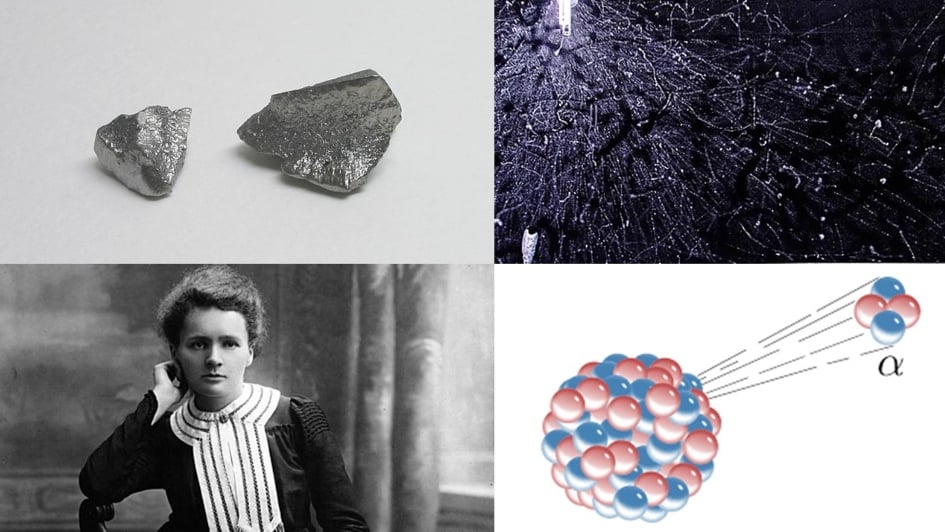Image: Composite image (clockwise from top left): two chunks of elemental lutetium; beta radiation emitted by a sample of strontium, visualised via a cloud chamber; atomic nucleus emitting alpha radiation; Marie Curie, discoverer of radium. Credit: W. Oelen, CC BY-SA 3.0; Nuledo, CC BY-SA 4.0; Shrriramsughir, CC BY-SA 4.0; Unknown author, Public domain; all via Wikimedia Commons.
Atomic energy
Radiotherapy is one of the staple cancer treatments we all know, alongside chemotherapy and surgery. It’s best known as a treatment delivered by an external beam of cell-zapping X-ray radiation.
But did you know that for decades we’ve also been using atomic energy to kill tumours from the inside out – produced by drugs that deliver radiation from patients’ own bloodstreams?
Known clinically as ‘radioisotope’ therapy, these treatments are based on injecting or swallowing radioactive versions of elements, sometimes called radionuclides or radioligands.
Lutetium
A new drug called Lu-177-PSMA is the latest atomic kid on the block, with a major recent paper – co-authored by the ICR’s Professor Johann de Bono – demonstrating promising results in men with advanced prostate cancer.
Lu-177 is a radioisotope, or radioactive form, of lutetium. Like all radioisotopes, each atom of Lu-177 wants to release one or more of its subatomic particles to become more stable. A sample of Lu-177 will divest itself of a stream of electrons – a high-energy form of radiation called beta radiation.
Lu-177 looks a good choice as a potential cancer treatment partly because it delivers a hefty dose of beta radiation but within a relatively small area, of around 2mm – minimising radiation damage to tissues around a tumour.
Ingeniously, scientists localise it to the cancer site by combining it – ‘conjugating’, in drug discovery parlance – with a molecule that attaches to a protein called prostate specific membrane antigen (PSMA), which is found on the surface of prostate cancer cells.
Radium
Radium-223 is one of several radioisotopes currently approved for, and routinely used in, cancer therapy. The ICR was instrumental in its development too: a trial led by Professor Chris Parker, Clinical Consultant at The Royal Marsden and Professor of Prostate Oncology at the ICR, proved its effectiveness in late-stage prostate cancer that has spread (or metastasised) to the bones.
Fascinatingly, radium-223’s chemical properties give it an in-built homing ability – from the same chemical group as calcium, which is taken up by growing bones, it’s taken up by metastatic cancer cells in bone. Radium-223 emits alpha radiation, or chunks of two protons bound to two neutrons, which has a relatively short reach.
Radioisotopes of strontium and samarium are also used in the treatment of bone metastases. Strontium sits in the same chemical group as radium and calcium, whereas samarium is one of the so-called actinides – a series of radioactive elements including lutetium and its better-known, more dangerous, cousins uranium and plutonium.
Yttrium
Yttrium-90 is used in a type of treatment called selective internal radiation therapy (SIRT), which isn’t widely available on the NHS. This involves injecting radioactive beads directly into blood vessels near a tumour and is used particularly in liver cancer treatment.
Iodine
Along with radioisotopes of phosphorus, which is now not used generally as a cancer therapy, iodine is one of the oldest radioisotopic cancer treatments. It’s been used in thyroid cancer treatment for more than 80 years, after a famous series of experiments and trials led by researchers at Massachusetts Institute of Technology (MIT).
Iodine-131 is still used as a treatment for thyroid cancers today. As with bone and calcium, the thyroid gobbles iodine at a much greater rate than the rest of the body, so the treatment naturally localises there. Iodine is interesting to medicinal chemists as one of the few non-metallic elements to be used for internal radiation treatment.
A recent paper from researchers in the Joint Department of Physics at the ICR and The Royal Marsden explores a particular issue for treatment with radioactive iodine, which is measuring how much of the radiation is actually absorbed by patients’ bodies.
The same team has led other studies exploring this idea of measuring radiation doses more effectively – known as ‘dosimetry’ – including developing innovative tools like the famous 3D-printed ‘Abdoman’.
… and that’s not all
Several other chemical elements have been used in the past as cancer treatments, or are being explored as experimental therapies.
Our researchers are working on discovering and developing a range of innovative new drugs, from radiopharmaceuticals to immunotherapies, small-molecule drugs to antibody-drug conjugates and newer drug types like PROTACs.
There’s an exciting future ahead in cancer drug discovery and development – whether you’re a chemistry geek or not!
